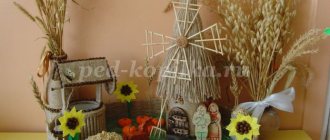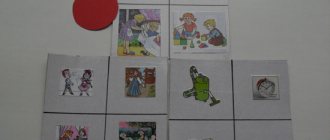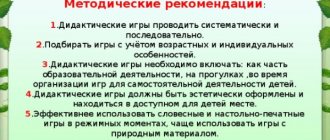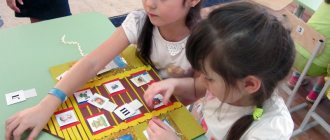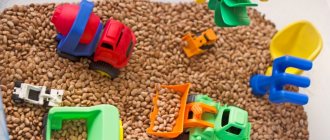Ecological games
on the development and formation of a correct attitude towards the surrounding nature contain a plot, use roles, rules, or contain only tasks. Actions in such games can be indicated by text, which determines the sequence of the game.
The games proposed by preschool teachers will help preschoolers love their native land and the surrounding animate and inanimate nature. Game exercises and manuals developed by preschool education specialists are easy to make and have one or more options for implementation.
Games and aids for environmental development and education
Contained in sections:
- Didactic games 32382
- Nature, ecology. Games, teaching aids 917
- Ecology for children. Ecolates, nature defenders 4215
Includes sections:
- Seasons, months, weeks. Games and teaching aids 1206
- Weather and nature calendar 241
- Sorting garbage and waste. Games, teaching aids 46
- Ecological signs. Rules of behavior in nature, in the forest 24
- Ecological lapbooks 249
By groups:
- Senior group
- Preparatory group
Showing publications 1-10 of 80. All sections | Ecology, nature protection. Didactic games and manuals
New
Photo
The best
Master class for educators on making a didactic game “Sorting waste - saving nature”
Master class for educators on making a didactic game “Sorting waste - saving nature !”
Prepared by: Chugunova Yu.A Goal: to increase the level of professional skills of teachers.
Objectives: Educational: Teach teachers how to make a didactic game “Sorting...
Didactic game “Remove garbage - save nature”
Purpose of the game : to help students familiarize themselves with the concepts of “waste sorting”
,
"recycling"
. Objectives: Develop the ability to classify objects according to the materials from which they are made. Develop logical thinking, observation, memory, attention, fine...
Author's manual on ecology “Nature Cube”
| Author: Khasanova Zulfiya Takbirshovna, teacher MADO "Kindergarten No. 44" in Tobolsk highest category. |
Our Motherland is great. Several natural zones change from north to south. Why is this happening? How do the flora and fauna of natural zones differ?
A guide for an exciting trip with kids through the natural areas of Russia will help answer these questions.
Spin the "Nature Cube"
And you will find on it,
Corners of a special country,
The one in which we live.
The purpose of the manual: to help preschoolers organize and systematize knowledge about the world around them, to understand the relationships in nature.
Tasks:
— Fostering sensitivity, kindness, and respect for nature; love for the Motherland;
— creating a need for acquiring environmental knowledge;
— formation of interest in objects of the surrounding world, living conditions of plants and animals;
- support children’s initiative, inquisitiveness, activity and independence in environmentally oriented activities;
— develop children’s personal cognitive experience.
Description of the manual: The manual is a cube, each face of which is a natural zone of Russia. At the bottom of the edges there are pockets for cards.
For ease of use, the cube is mounted on a rotating disk. The manual is accompanied by cards with images of representatives of flora and fauna of various natural zones . Posters from the “Natural Zones of Russia” series were used for production.
K ub is intended for children of senior preschool age. It is universal: it will help children not only get acquainted with animals and plants from different parts of our country, see the beauty and diversity of nature, but also broaden the pupils’ horizons, develop their memory, attention, thinking, and speech. Helps increase the child's cognitive activity.
The manual can be used both in joint activities of a child and an adult, and for independent and group games.
Options for games and exercises:
“Where do these plants grow?”
“Where do these animals live?”
“Help animals and plants find their home.”
Children help animals and plants find their home by choosing suitable climatic conditions.
"Find the odd one out"
"Continue the series"
“Help me fix the mistake.”
Children compare animals, find similarities and differences between them, common and different in plants, learn to notice interesting features of the appearance and behavior of animals.
“Find out by description.”
Children are asked to identify the natural area based on the description.
“Make a match.”
Children learn to establish correspondence: a natural area - its climate, plants, animals, birds.
"Make a story."
Based on the manual, you can talk about an animal or plant, compose and solve riddles.
Dear teachers and parents - participants of the exhibition!
On June 2, 2015, a solemn ceremony of awarding the winners of the regional methodological exhibition “Modern educational environment of kindergarten and family” took place at the information and exhibition complex of the Tyumen Regional Duma. Details >>>
From June 8 to June 10, 2015, teachers from Tyumen received certificates of exhibition participants and multimedia albums with the full version of the exhibition at the Grant Center for the Development of Creativity for Children and Youth at the address: Profsoyuznaya St., 52. tel. for inquiries: 685-321,
June 9, 2015 Diplomas, certificates and gifts were sent to the winners and participants of the Exhibition of the south of the Tyumen region, Yamal-Nenets Autonomous Okrug and Khanty-Mansi Autonomous Okrug-Yugra by registered parcel post to the address of the preschool educational institution. Details >>>
Share
Photo report “Ecological games for preschoolers”
LYUDMILA EFREMOVA
Photo report “Ecological games for preschoolers”
A variety of games with environmental content not only introduce the child to the world around them, but also help to form a system of social values oriented towards caring for nature.
While playing, the child gets acquainted with the diversity of nature and learns that everything on Earth is interconnected.
Children get acquainted with the diversity and uniqueness of the animal and plant world, notice the peculiarities of life and behavior.
Learn about the peculiarities of life of living creatures at different times of the year.
Environmental games have a great impact on mental development. Children learn to reason, draw conclusions, generalize, while their attention and memory are trained, and voluntary perception develops. By solving problems posed in the game, the child learns to isolate individual characteristics of phenomena or objects: compare, group, classify according to certain features and characteristics.
Also, in the process of environmental games, vocabulary is enriched: children learn the names of animals, birds, plants, insects, and learn to describe their appearance and characteristic features.
Didactic game with clothespins “What do animals eat?
Goal: to consolidate children's knowledge about animal nutrition, develop cognitive interest, fine motor skills, expand and activate vocabulary, and develop memory and thinking.
Didactic puzzle game “What do animals eat?”
Didactic game with clothespins “Guess who lives where?”
Goal: to consolidate children’s knowledge about the habitat of various representatives of nature, develop cognitive interest, fine motor skills, expand and activate vocabulary, and develop memory and thinking.
Didactic lotto game “Guess who lives where?”
Didactic game with clothespins “Which animal does the body part belong to?”
Goal: to consolidate children's knowledge about the body structure of various representatives of nature, to develop cognitive interest, fine motor skills of the hands, to expand and activate the vocabulary, to teach children to correctly form possessive adjectives, and to develop the ability to analyze.
Didactic game with clothespins “Whose tail?”
Didactic game with clothespins “Which tree is the fruit from?”
Goal: to consolidate children’s knowledge about plants, develop cognitive interest, fine motor skills, expand and activate vocabulary, and develop memory and thinking.
Didactic game with clothespins “Tops and roots. "
Collection of didactic games on environmental education
Progress of the game
: The teacher distributes vegetables and fruits to the children and invites them to “mix them up.” At the signal: “Find your vegetable!” - children, holding vegetables and fruits of the same name, gather in groups. Moreover, within each group they must position themselves in such a way that it is clear what comes first, what comes next, that is, follow the sequence of ripening - from unripe to ripe. The link that assembles quickly and stands in the correct sequence wins.
During the game, children change objects several times.
"Magic Screens"
Target
: development in children of the ability to organize objects by property, understand the conventions of notation, analyze, and compare objects.
Material
: “Screen” with three “slot windows” into which tapes with symbols of properties are inserted. Ribbons are strips depicting objects with varying degrees of properties (for example, a large, medium and small apple).
Rules and course of the game: the teacher or one of the children inserts an image of an object in the first “window”. He suggests choosing a “family” - building an ordered row.
For example: large circle, then medium, small; dark spot – light, very light, etc. At the beginning of mastering the game, the content is specially designed: a property is selected, pictures with a clear manifestation of this property are selected. In the future, you can use images with multiple properties. For example, in the first “window” there is a red apple, in the second and third “windows” there are apples of different shape, color, and size. Children discuss how to build a series, which property to choose.
GAMES FOR CHILDREN'S FAMILIARY
WITH PLANTS
"Flower shop"
Target:
consolidate the ability to distinguish colors, name them quickly, find the right flower among others. Teach children to group plants by color and make beautiful bouquets.
Visual material:
pictures of vegetables.
The teacher says: “One day a tomato decided to gather an army from vegetables.” They came to her with peas, cabbage, cucumbers, carrots, beets, onions, potatoes, and turnips. (The teacher puts pictures of these vegetables on the stand one by one) And the tomato told them: “There were a lot of people willing, so I set the following condition: first of all, only those vegetables will go to my army whose names have the same sounds as mine.” tomato." - What do you think, children, what vegetables responded to his call? Children name, highlighting the necessary sounds with their voices: peas, carrots, potatoes, turnips, cucumber, and explain that these words contain the sounds p, p, as in the word tomato. The teacher moves pictures depicting the named vegetables on the stand closer to the tomato. Tomato conducts various training sessions with peas, carrots, potatoes, and turnips. Good for them! And the rest of the vegetables were saddened: the sounds that make up their names in no way fit the sounds of the tomato, and they decided to ask the tomato to change the condition. Tomato agreed: “Have it your way!” Come now, those whose names have as many parts as mine.” - What do you think, children, who responded now? Together we find out how many parts there are in the word tomato and in the name of the remaining vegetables. Each answer explains in detail that the words tomato and, for example, cabbage have the same number of syllables. Pictures depicting these plants also move towards the tomato. “But the onions and beets were even more saddened. Why do you think, children? The children explain that the number of parts in the name is not the same as that of a tomato, and the sounds do not match. - How to help them. Guys? What new condition could a tomato offer them so that these vegetables would join his army? The teacher should lead the children to formulate the following conditions themselves: “Let those vegetables come whose names have an emphasis in the first part” or “We accept into the army those whose names contain the same sounds (onions, beets).” To do this, he can invite the children to listen and compare where the stress is in the remaining words - the names of vegetables, and compare their sound composition. “All the vegetables became warriors, and there was no more grief!” - concludes the teacher.
